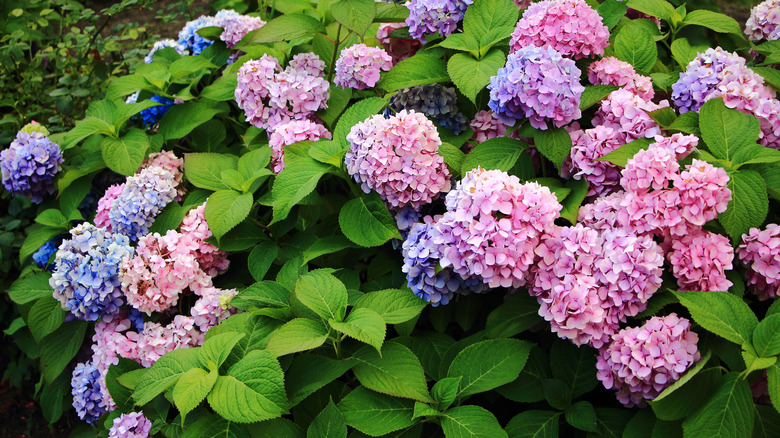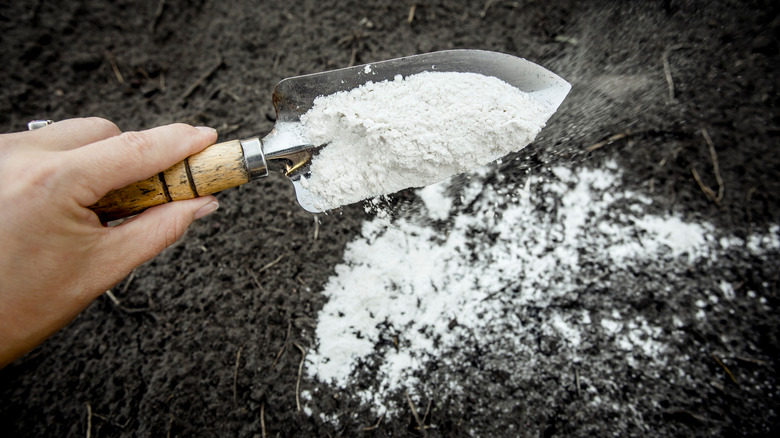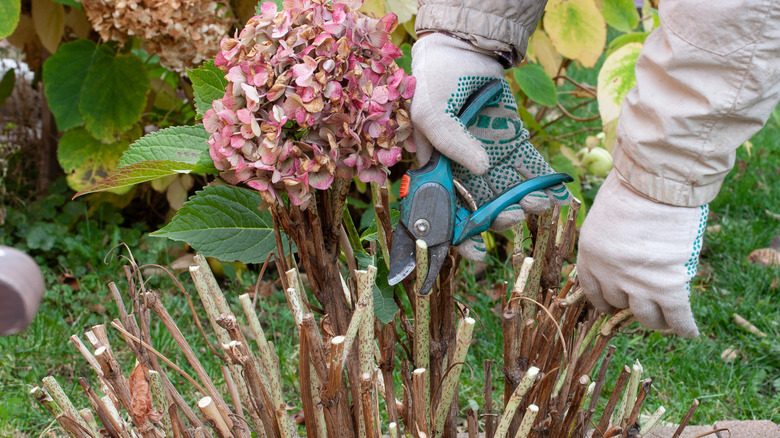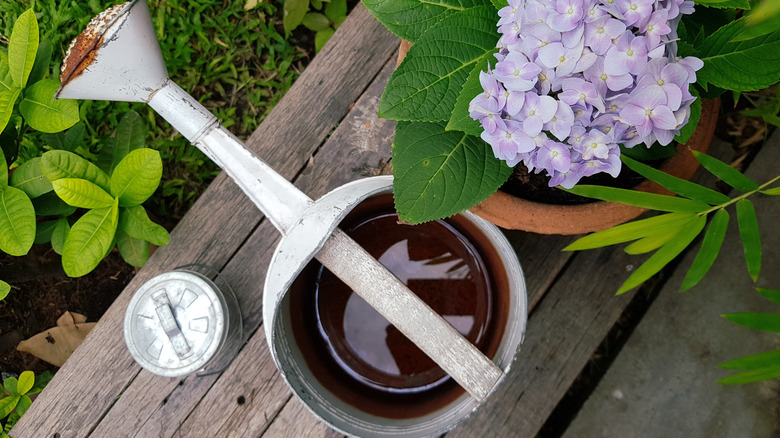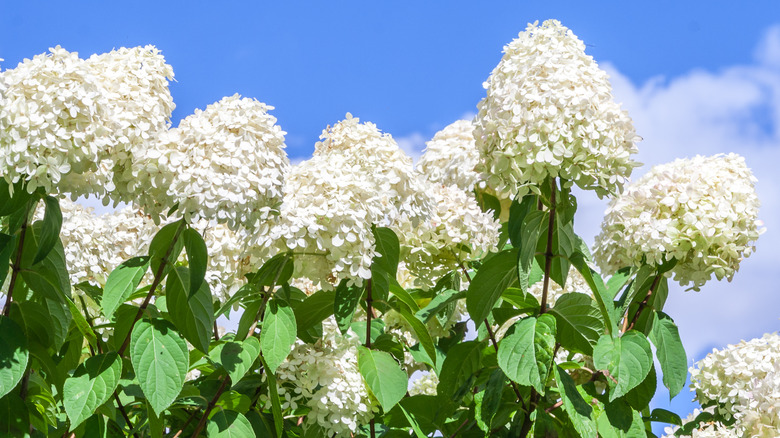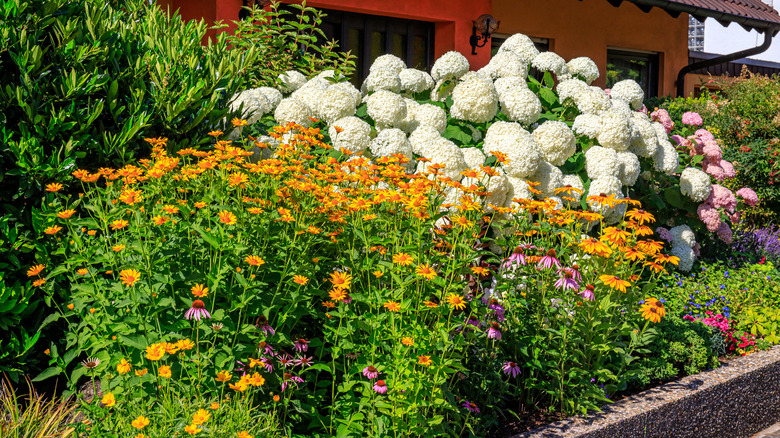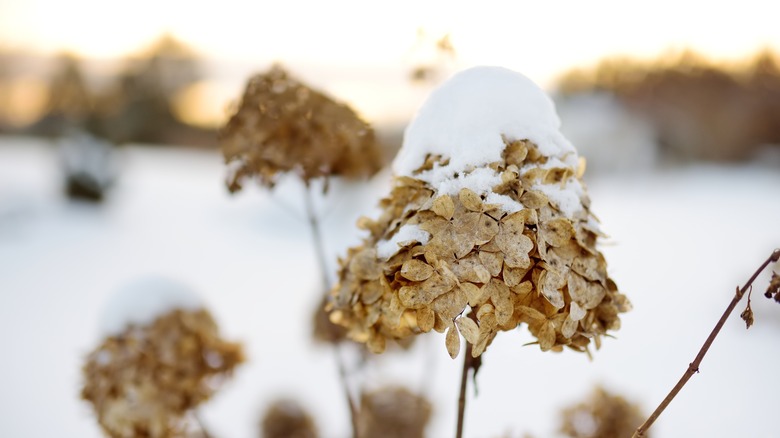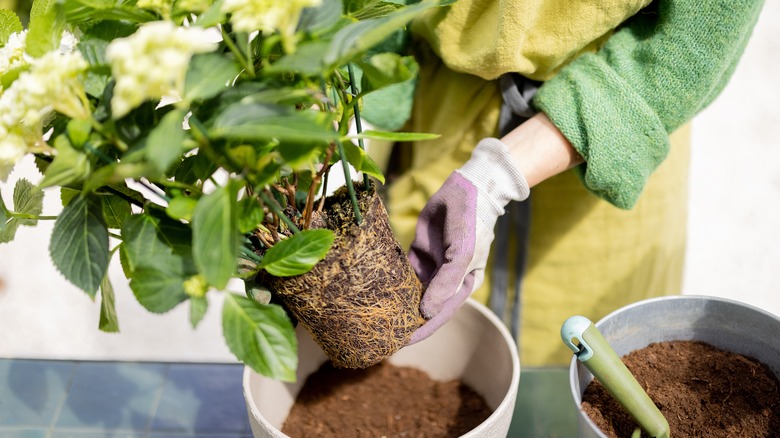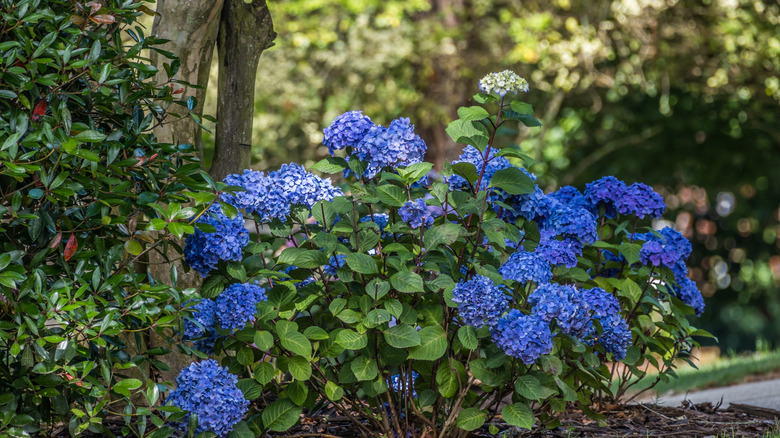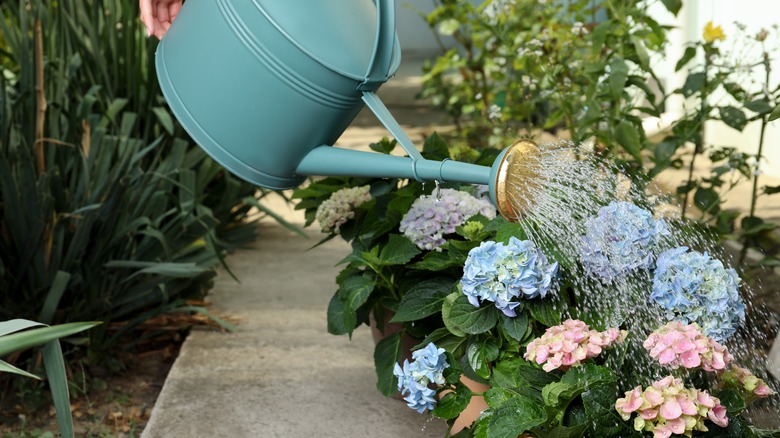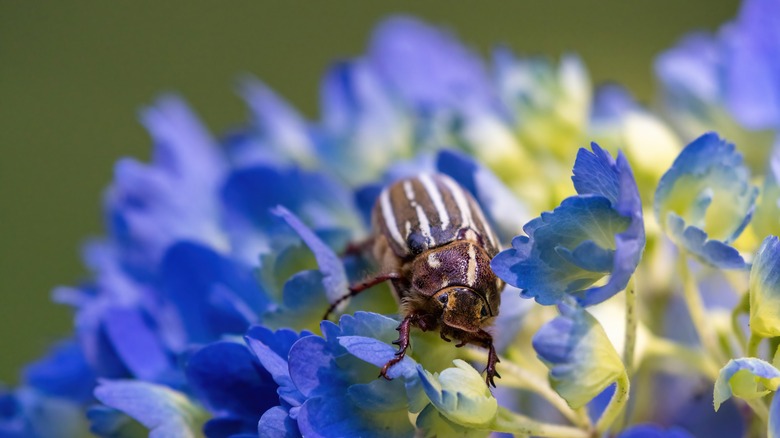10 Mistakes Everyone Makes When Planting Hydrangeas
Beloved for their large, flowering heads and beautiful presence in garden designs, hydrangeas are a favorite choice for both new and seasoned gardeners. They serve as an elegant statement plant that can do wonders for your curb appeal. Not to mention, hydrangeas are great cutting flowers to make beautiful, colorful arrangements all over your home. What's not to love? The flowering shrub is relatively easy to grow and maintain, as long as you avoid some common mistakes everyone makes when planting them.
Maybe you purchased one excitedly from the garden center, agonized over the perfect spot to plant it, and then ... nothing — not a single bloom to reward you for all of your time and effort. If you scour any gardening blogs or discussion forums, you'll see this is a common problem that plagues many other green thumbs. Take heart that you're not alone, and then follow this checklist. There's a good chance that one of these common mistakes is to blame for your hydrangea woes. And remember, since perennials usually take three years to mature, you'll need to be patient with your new bush. The end result will be worth it, though, and once you use a bit of patience and care, your hydrangea plants will take off and look absolutely extraordinary in your yard.
Over-fertilizing
While fertilizer delivers key nutrients to plants and greatly improves their health, too much fertilizer — or over-fertilizing — can have the opposite effect and cause detrimental damage. If your hydrangeas aren't blooming, don't dump fertilizer all over them and hope for the best. You'll end up with scorched plants from fertilizer burn, tons of foliage but no blooms, or even both!
There are lots of choices for fertilizer, and it can be an overwhelming decision to have so many options in front of you. If you're looking for simplicity, Gardening Know How suggested a yearly application of a slow-release chemical that's specifically made for trees and shrubs. If you'd prefer to use an organic option instead, try a combination of peat moss, compost, and sulfur. When you're ready to apply the fertilizer, cover the area so that it surrounds the drip line — aka the space under the outer circumference of a plant's branches — and not directly at the base of your hydrangea. Once it's all spread out, water your plants.
Improper pruning
Hydrangeas are extremely temperamental when it comes to pruning. There's no "one size fits all" set of instructions for pruning them, because it varies greatly between the types. If you cut at the wrong time, you could be destroying next year's blooms, or if you cut back too much, you might stunt the growth. What's a home gardener to do?
To avoid long-term repercussions as a result of improper pruning, determine if your particular variety of hydrangea blooms on old wood or new wood. Fine Gardening noted that the only time old growth varieties should be pruned is after they stop producing flowers. Varieties that bloom on new growth, however, should either be pruned in the spring or the fall. If you prune in the spring, you can do so after the last frost, but make sure to complete your pruning before any small, green buds appear. If you see the green buds, the hydrangea is already awake and shouldn't be trimmed. If you want to prune in the fall, the plants will be dormant and at no risk for harm.
Fine Gardening offered a tip if your hydrangeas are prone to flopping — aka weight of the flowers causes the plant to collapse, especially after a heavy rainfall. If you trim the stems so that they are 18 to 24 inches high, this helps give the bush a strong enough base to hold up heavy blooms. As your hydrangea matures over the years, this base will grow stronger.
Overwatering
We know that all plants need water to survive, but if you douse your hydrangea with too much water, you're going to harm it. According to Gardening Know How, hydrangeas like moist, well-draining soil. The key here is moist, not drenched. Once you start to overwater your plants, it won't be long before the roots begin to rot. SFGATE explained that rotting roots will lead to yellowing leaves, stunted flower growth, and overall failure to thrive. A good rule of thumb is to stick your finger down into the soil at the base of the hydrangea. If the dirt is dry, go ahead and give it a nice drink of water. If the dirt is still moist, hold off on watering.
It's important to note that there is a (slight) exception to this — and that comes into play with droughts. If your area experiences a severe drought during the summer months, you'll definitely need to increase how much you're watering. Watch out for droopiness or curling, dry leaves, as these are telltale signs that the hydrangea needs a drink during a drought.
Too much sunlight
Though many hydrangea varieties can tolerate full sun, that doesn't mean they'll be happiest in such a setting. In general, the flowering shrub does best in morning sun and afternoon shade. Certain varieties can tolerate more sunlight than others, so be sure to read the care tag of your particular plant to ensure it receives the proper amount of light.
If your hydrangea is getting scorched by the sun, there are a few things you may begin to notice. Gardening Know How noted that droopy hydrangeas are usually caused by a combination of too much direct sun (this zaps the shrub's energy) and that they need more water (which helps it bounce back from the stress of the sun). Maybe yours aren't drooping, but the blooms fade quickly or never seem to reach their full potential. HGTV warned that too much sunshine is usually the cause of faded, lackluster blooms.
Your best solution would be to transplant the hydrangeas to a shadier location once they're dormant, but if that's not an option, you'll need to be more diligent with more frequent watering. Additionally, HGTV suggested adding a layer of mulch around the base of the shrub to help retain some of the moisture.
Poor plant placement
With the exception of dwarf varieties, hydrangeas need space to expand as they mature and get bigger. The plant might not look like much when you bring it home from the garden center in its gallon-sized pot, but just give it a few years. According to Hyannis Country Garden, the Nikko Blue hydrangea, for example, can grow to an astounding size of eight feet wide and six feet tall. If you didn't plan accordingly when you did your garden layout and plant placement, your hydrangeas may start crowding each other or the plants around them. When this happens, they won't be able to bloom to their full potential. By planting in a poor location, you may be forced to prune excessively in an attempt to combat the overcrowding.
Another problem? Planting in an area that has too much shade and not enough sunlight, as per DIY Network. You'll likely end up with a hydrangea that's heavily-leafy but produces very few flowers. Instead, do a little research before you start digging. This will ensure proper spacing that can accommodate the growth of your hydrangeas in the coming years, as well as guarantees the proper balance of sunshine and shade. A small amount work up front will save you tons of work in the long run.
Not protecting hydrangeas from winter weather
In some instances, you may need to protect your hydrangeas from the winter weather. Plant Addicts explains that blue and pink mophead hydrangeas, or H. macrophylla, will only need protection if the outdoor temperatures fall below 5 to 10 degrees Fahrenheit. If the temperatures in your area consistently stay above this range, it is not necessary to protect your hydrangeas. Similarly, smooth and paniculata hydrangea varieties do not require protection.
If you live in a region that experiences bitterly cold winters and have blue and pink mophead hydrangeas, you will want to take measures to protect them against cold temperatures. To protect a hydrangea, you'll want to use chicken wire, burlap, or another breathable material to construct a frame around the plant. Then you will need to add some insulation and work it into the structure's openings. Take care not to place any of your insulation materials too close to the bloom buds to avoid damaging them as the insulation materials move around over the winter. Leave the cover over the hydrangeas until the season's last frost has passed. You don't want to uncover it too soon only to have the leaves damaged by a cold snap.
Alternatively, you could choose to plant your hydrangeas in large flower pots. This way, when the temperatures start to drop, you can move them into the garage, where it should be a bit warmer than outside. Just be careful to choose a pot that is large enough to handle a hydrangea's roots.
Not planting hydrangeas in well-draining soil or a pot with drainage
If you're planting hydrangeas, you want them to thrive. As with other types of plants, choosing the right soil type is essential when planting hydrangeas. According to Rooting for Blooms, well-draining soil is best for a hydrangea. Look for either loam or sandy-loam soil, as these types will offer the ideal drainage for a hydrangea to prosper.
When soil is too heavy and doesn't offer proper drainage, it allows water to stay at the surface. Too much standing water can lead to rotten roots. Conversely, if the soil lets nearly all the moisture drain out, it will leave the hydrangea too dry.
While hydrangeas are pretty picky about the soil composition, they are less fussy about pH levels than several other plants. Typically, a pH level between 6.0 and 7.0 is recommended for most garden or houseplants. However, hydrangeas are more flexible and can continue to grow well if the soil's pH is between 5.0 and 8.0. Just keep in mind that the soil's pH level can alter some hydrangeas' color.
Planting hydrangeas beneath a tree
Hydrangeas are known as one of the plants that can grow well in the shade. However, don't make the mistake that many individuals do in assuming that this means that they'll grow best under a tree. All About Gardening explains that while hydrangeas grow well in shady areas, planting them directly under a tree will not have the desired effect.
When you plant a hydrangea under a tree, it has to compete with it for nutrients and water. A tree needs much more nutrients than a flower bed, so the hydrangea will always come up short. Moreover, the tree's leaves could interfere with water making it to the hydrangea when it rains, further limiting its access to needed resources.
Another reason not to place a hydrangea under a tree is that they do need to get some sunlight — ideally during the morning — to really thrive. Instead of trying to plant your hydrangeas under a tree, opt for an area of your yard that has partial shade. As noted above, try to place them in a location where they'll get a few hours of morning sunlight before the temperatures get too warm.
Using an overhead sprinkler to water hydrangeas
Southern Living explains that hydrangeas should not be watered using an overhead sprinkler system. Watering hydrangeas from above — whether with a sprinkler or a soaker hose — can lead to fungal problems. Instead, it is better to water where the hydrangea meets the soil. Doing so helps direct the water to the roots instead of leaving it to accumulate on the flowers or leaves of the plant.
It is also important to know when to water your hydrangeas to help them really thrive. "Every garden is different, so if the top inch of soil is dry, it's time to water," explains Georgia Clay, New Plants Manager at Monrovia. Following this rule will provide adequate water to the hydrangeas, keep them from drying up, and allow them to grow to their full potential.
The best time of day to water them is during the morning. Sticking with a morning watering schedule will give the leaves sufficient time to dry out before it gets too hot. If the plants are watered too close to the heat of the day, the sun may reflect off the drops of water and scorch the leaves.
Not keeping an eye out for pests and diseases
Hydrangeas are typically less impacted by pests or diseases than some other plants. However, as Epsoma explains, it is still possible for them to become infested or damaged, so you'll want to check on your plants periodically.
Some common pests to look out for include scale, aphids, beetles, and slugs. In addition to these pests, hydrangeas may also develop different diseases. These can include black fungus over the leaves that can be a sign of overwatering during drier times, rust-colored spots that may cause the leaves to change to yellow or brown and fall off of the plant, and a powder-like substance over the leaves that can result in fallen leaves. If you keep a regular routine of watering the roots of your hydrangeas during the morning hours, you can likely prevent many of the diseases that impact this plant.
